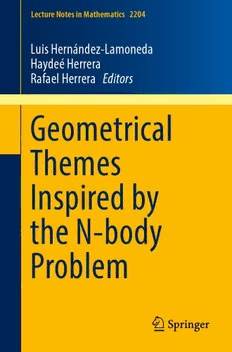Table Of ContentLecture Notes in Mathematics 2204
Luis Hernández-Lamoneda
Haydeé Herrera
Rafael Herrera Editors
Geometrical
Themes
Inspired by
the N-body
Problem
Lecture Notes in Mathematics 2204
Editors-in-Chief:
Jean-MichelMorel,Cachan
BernardTeissier,Paris
AdvisoryBoard:
MichelBrion,Grenoble
CamilloDeLellis,Zurich
AlessioFigalli,Zurich
DavarKhoshnevisan,SaltLakeCity
IoannisKontoyiannis,Athens
GáborLugosi,Barcelona
MarkPodolskij,Aarhus
SylviaSerfaty,NewYork
AnnaWienhard,Heidelberg
Moreinformationaboutthisseriesathttp://www.springer.com/series/304
Luis Hernández-Lamoneda (cid:129) Haydeé Herrera (cid:129)
Rafael Herrera
Editors
Geometrical Themes Inspired
by the N-body Problem
123
Editors
LuisHernández-Lamoneda HaydeéHerrera
DepartmentofMathematics DepartmentofMathematics
MathematicsResearchCenter(CIMAT) RutgersUniversity
Guanajuato,Mexico Camden,NJ
USA
RafaelHerrera
DepartmentofMathematics
MathematicsResearchCenter(CIMAT)
Guanajuato,Mexico
ISSN0075-8434 ISSN1617-9692 (electronic)
LectureNotesinMathematics
ISBN978-3-319-71427-1 ISBN978-3-319-71428-8 (eBook)
https://doi.org/10.1007/978-3-319-71428-8
LibraryofCongressControlNumber:2018931934
MathematicsSubjectClassification(2010):70F07,37J45,37J29,34M99,53C15,37D15,53D12,57R58
©SpringerInternationalPublishingAG2018
Thisworkissubjecttocopyright.AllrightsarereservedbythePublisher,whetherthewholeorpartof
thematerialisconcerned,specificallytherightsoftranslation,reprinting,reuseofillustrations,recitation,
broadcasting,reproductiononmicrofilmsorinanyotherphysicalway,andtransmissionorinformation
storageandretrieval,electronicadaptation,computersoftware,orbysimilarordissimilarmethodology
nowknownorhereafterdeveloped.
Theuseofgeneraldescriptivenames,registerednames,trademarks,servicemarks,etc.inthispublication
doesnotimply,evenintheabsenceofaspecificstatement,thatsuchnamesareexemptfromtherelevant
protectivelawsandregulationsandthereforefreeforgeneraluse.
Thepublisher,theauthorsandtheeditorsaresafetoassumethattheadviceandinformationinthisbook
arebelievedtobetrueandaccurateatthedateofpublication.Neitherthepublishernortheauthorsor
theeditorsgiveawarranty,expressorimplied,withrespecttothematerialcontainedhereinorforany
errorsoromissionsthatmayhavebeenmade.Thepublisherremainsneutralwithregardtojurisdictional
claimsinpublishedmapsandinstitutionalaffiliations.
Printedonacid-freepaper
ThisSpringerimprintispublishedbySpringerNature
TheregisteredcompanyisSpringerInternationalPublishingAG
Theregisteredcompanyaddressis:Gewerbestrasse11,6330Cham,Switzerland
Preface
TheSeventhMini-MeetingonDifferentialGeometrywasheldfromFebruary17th
to 19th, 2015, at the Center for Research in Mathematics (CIMAT), Guanajuato,
México.
The invited speakers included Adolfo Guillot, Richard Montgomery (Distin-
guished Visiting Professor for the Mexican Academy of Sciences and the USA-
MexicoFoundationforScience),andAndrésPedroza.Thelectureswereorganized
intothreeadvancedminicourses(threelectureseach).
This volumeconsists of the lecture notesofthe minicourseswhose contentwe
describebriefly:
(cid:129) Guillot’s notes exploresome differentialequationsin the complexdomain that
can be studied through the understanding of geometric structures (projective,
affine) on complex curves. The study of such systems is motivated by the
problem of describing the evolutionof N particles movingin the plane subject
to theinfluenceofa magneticfield.Forinstance,in theabsenceofinteractions
(vanishing interaction constants), the particles move periodically in circles, all
of them with the same period (the system is isochronous). The search for the
nonzerovaluesoftheinteractionconstantsthatrenderthesystemisochronousis
theguidingprincipleforthetheorythatisdeveloped.
(cid:129) Montgomery’s notes deal with the solution to a generalization of the well-
knowntheoreminRiemanniangeometryassertingthatonacompactRiemannian
manifold,everyfreehomotopyclassofloopsisrealizedbyaperiodicgeodesic.
Inspiredbythis fundamentalgeometricfact, Wu-yi-Hsiangposedthe question:
“Is every free homotopy class realized for the planar Newtonian three-body
equation?” In the case of equal or nearly equal masses, and for all nonzero
angular momentum sufficiently small, every free homotopy class on the two-
sphere minus three points is realized by a relatively periodic orbit for the
three-bodyproblem.Theexpositionofthesolutiontothisprobleminvolvesnot
onlygeometrybutalsodynamicalmethodsandtheMcGeheeblow-up.Themain
noveltyistheuseofenergybalancetomotivatethemysterioustransformationof
McGehee.
v
vi Preface
(cid:129) Pedroza’s notes present a brief introductionto the recent and importanttheory
of Lagrangian Floer homology and its relation with the solution of Arnol’d
conjecture on the minimal number of nondegenerate fixed points of a Hamil-
tonian diffeomorphism. A sketch of various aspects of Morse theory and an
introductiontothebasicconceptsofsymplecticgeometryareincluded,withthe
aimofunderstandingthestatementoftheArnol’dconjectureandhowitrelates
toLagrangiansubmanifolds.
Wethankalltheparticipantsformakingthemeetingasuccessfulandstimulating
mathematicalevent.WealsothankCIMAT’sstafffortheirhelpintheorganization
andsmoothrunningoftheevent.Thismeetingwastheseventheditionofanannual
eventintendedforresearchersandgraduatestudents,withthedualaimofcombining
a winter school and a research workshop. The meeting was supported by the
Mexican Academy of Sciences (AMC), the USA-Mexico Foundation for Science
(FUMEC), the Mexican Science and TechnologyResearch Council (CONACyT),
and the Center for Research in Mathematics (CIMAT). The organizerswere Luis
Hernandez-Lamoneda (CIMAT, México), Haydeé Herrera (Rutgers, USA), and
RafaelHerrera(CIMAT,México).
Guanajuato,Mexico LuisHernández-Lamoneda
Camden,NJ,USA HaydeéHerrera
Guanajuato,Mexico RafaelHerrera
Contents
ComplexDifferentialEquationsandGeometricStructuresonCurves.... 1
AdolfoGuillot
Blow-Up,HomotopyandExistenceforPeriodicSolutions
ofthePlanarThree-BodyProblem............................................. 49
RichardMontgomery
AQuickViewofLagrangianFloerHomology................................ 91
AndrésPedroza
vii
Complex Differential Equations and Geometric
Structures on Curves
AdolfoGuillot
Abstract Thesearethenotesofaseriesoflecturesonordinarydifferentialequa-
tionsinthecomplexdomaindeliveredatthe“SeventhMinimeetinginDifferential
Geometry”atCIMAT,inGuanajuato,Mexico,in2015.Weusegeometricstructures
oncurvesasa settingtopresentsomehistoricalresultsofthetheoryandasatool
forabetterunderstandingofsomeclassicalequations.
These are the notes of a series of lectures delivered at the “Seventh Minimeeting
inDifferentialGeometry”atCIMAT,inGuanajuato,Mexico,in2015.Someofits
materialappearedalreadyinthelecturesgivenattheCIMPASchool“Singularités
des Espaces, des Fonctions et des Feuilletages” that took place in Fez, Morocco,
in 2012. The lectures were intended as an invitation to differential equations in
the complex domain, focusing on some geometric aspects, and explored some of
thecomplexdifferentialequationsthatcanbestudiedthroughtheunderstandingof
some geometric structures(projective,affine) on complexcurves. The course was
addressedto peoplewith some basic knowledgeof ordinarydifferentialequations
and complex analysis but possibly no previous acquaintance with differential
equationsinthecomplexdomain.Theideaofthelectureswastousethegeometric
descriptionof some particulardifferentialequations(manyof them classical) as a
settingtopresentsomehistoricalresultsofthetheory,likeSchwarz’stheoremonthe
uniformizationofplanepolygonsorFuchs’stheoremonthe singularitiesoflinear
differentialequations.We also use thisgeometricdescriptionasa toolfora better
understandingofsomeofthefeaturesoftheseequations.
The author thanks Rafael Herrera for his invitation to lecture at the “Seventh
Minimeetingin DifferentialGeometry”,as wellasfor hisencouragementto write
thesenotes.
A.Guillot((cid:2))
InstitutodeMatemáticas,UnidadCuernavaca,UniversidadNacionalAutónomadeMéxico,
A.P.273-3Admon.3,Cuernavaca62251,Morelos,Mexico
e-mail:[email protected]
©SpringerInternationalPublishingAG2018 1
L.Hernández-Lamonedaetal.(eds.),GeometricalThemesInspired
bytheN-BodyProblem,LectureNotesinMathematics2204,
https://doi.org/10.1007/978-3-319-71428-8_1
2 A.Guillot
1 Calogero’s “Goldfish,”ComplexDifferential Equations
andTranslationStructures
1.1 The“Goldfish”Many-BodyProblem
LetusconsidertheproblemofdescribingtheevolutionofNparticlesmovinginR3
subjecttotheequations
X .rP (cid:4)r /rP C.rP (cid:4)r /rP (cid:3)r .rP (cid:4)rP /
rR D!(cid:2)(cid:2)rP (cid:3) (cid:3) k jk j j jk k jk j k ; jD1;:::N: (1)
j j jk jr j2
k¤j jk
Here, the position of the jth particle is given by r 2 R3 and r D r (cid:3)r ; the
j jk j k
constant(cid:3) 2 Rmeasurestheinfluenceofthekthparticleuponthejthone.There
jk
isamagneticvectorfieldhaving(cid:2) D .0;0;1/fordirection,and! 2Risanatural
frequencyofthesystem(! ¤0).WedenotebyfP thederivativeoff withrespectto
theindependentvariable(cid:4).
If at one instant all the particles are in the plane … (cid:5) R3 given by z D 0 and
all their velocities are tangent to this plane, the particles will remain within this
planethroughouttheirmotion.The“goldfish”many-bodyproblemcorrespondsto
the restrictionofthe system (1)to thisplane …,this is, when,foreveryj, r.t/ D
j
.x.t/;y.t/;0/. A slightly more general version of this system was introduced
j j
by Calogero and Françoise in [7] as a generalization of the original “goldfish,”
appearingin[6].Theterm“goldfish”wascoinedbyCalogero,borrowingtheterm
fromZakharov,asametaphorforanextraordinaryfishthatcanonlybecaughton
veryrareoccasions.
Inthe“goldfish”problem,theparticlesmovewithintheplane…andaresubject
to the influence of a magnetic field that is orthogonal to it. In the absence of
interactions (when (cid:3) D 0 for every j and k), the particles move periodically in
jk
circles, and all of them do so with period 2(cid:5): the period is independent of the
initial condition.Systems as these, where for almost every initial conditionorbits
are periodic with the same period are called isochronous. The following problem
willguideourdiscussion.
Problem1 Determine the values of the interaction constants f(cid:3) g that give
jk
isochronous settings for system (1) in the “goldfish” setting (the one where the
particlesevolvewithintheplane…wherethethirdcoordinatevanishes).
For example, in the two-body “goldfish” system (1), isochronicity occurs
if(cid:3)12 D 3and(cid:3)21 D 3(thiswillbeprovedinExample5).Anorbitisportrayed
in Fig.1a. For (cid:3)12 D 3:1 and (cid:3)21 D 3:1, the orbitfor the same initial conditions
appears in Fig.1b, where one can see that the orbits do no close like in (a). This
systemisnotisochronous.

